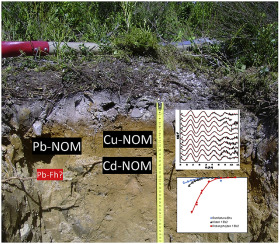Chemosphere ( IF 8.1 ) Pub Date : 2018-01-04 , DOI: 10.1016/j.chemosphere.2018.01.004 Charlotta Tiberg , Carin Sjöstedt , Jon Petter Gustafsson

|
While metal sorption mechanisms have been studied extensively for soil surface horizons, little information exists for subsoils, for example Spodosol Bs horizons. Here the sorption of cadmium(II), copper(II) and lead(II) to seven Bs horizons from five sites was studied. Extended X-ray absorption fine structure (EXAFS) spectroscopy showed that cadmium(II) and lead(II) were bound as inner-sphere complexes to organic matter. Addition of o-phosphate (to 1 μmol l−1) did not result in any significant enhancement of metal sorption, nor did it influence EXAFS speciation. An assemblage model using the SHM and CD-MUSIC models overestimated metal sorption for six out of seven soil samples. To agree with experimental results, substantial decreases (up to 8-fold) had to be made for the fraction ‘active organic matter’, fHS, while the point-of-zero charge (PZC) of ferrihydrite had to be increased. The largest decreases of fHS were found for the soils with the lowest ratio of pyrophosphate-to oxalate-extractable Al (Alpyp/Alox), suggesting that in these soils, humic and fulvic acids were to a large extent inaccessible for metal sorption. The low reactivity of ferrihydrite towards lead(II) can be explained by potential spillover effects from co-existing allophane, but other factors such as ferrihydrite crystallisation could not be ruled out. In conclusion, organic matter was the predominant sorbent for cadmium(II), copper(II) and lead(II). However, for lead(II) the optimised model suggests additional, but minor, contributions from Fe (hydr)oxide surface complexes. These results will be important to correctly model metal sorption in spodic materials.
中文翻译:

金属对Spodosol Bs的吸附:有机物络合物占主导地位
尽管已经对土壤表层的金属吸附机理进行了广泛研究,但对于地下土壤(例如Spodosol Bs层)的信息很少。在此研究了从五个位置到七个Bs层的镉(II),铜(II)和铅(II)的吸附。扩展的X射线吸收精细结构(EXAFS)光谱表明,镉(II)和铅(II)作为内球络合物与有机物结合。添加邻磷酸酯(至1μmoll -1)不会导致金属吸附的任何显着增强,也不会影响EXAFS的形成。使用SHM和CD-MUSIC模型的组合模型高估了七个土壤样品中六个的金属吸附。为了与实验结果一致,必须对分数“活性有机物” f HS进行大幅降低(最多8倍),同时必须增加三水铁矿的零电荷(PZC)。的最大下降˚F HS被发现对于具有最低比土壤焦到草酸盐可提取的Al(铝PYP / Al的牛),表明在这些土壤中,腐殖酸和黄腐酸在很大程度上无法吸收金属。铁水合物对铅(II)的低反应性可以通过共存的别铝烷的潜在溢出效应来解释,但不能排除诸如铁水合物结晶等其他因素。总之,有机物是镉(II),铜(II)和铅(II)的主要吸附剂。但是,对于铅(II),优化的模型建议由氢氧化铁(氢氧化物)表面配合物提供额外但次要的贡献。这些结果对于正确地模拟偶发材料中的金属吸附非常重要。











































 京公网安备 11010802027423号
京公网安备 11010802027423号